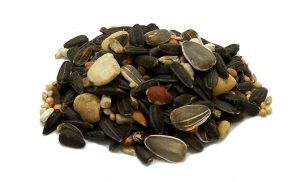Seedy Business
By Andrew Jobes, for The Avant-Garden Shop

The majority of the contents in most bird seed mixes available at large stores is a blend of “fillers” that are low in nutritional value, such as wheat, red millet, and flax. The seeds in these bulk bags are often poorly cleaned, which leaves them dusty, and oils are then added to reduce the dust. So, although $10 or $20 might seem like a steal for a large bag of seed, it doesn’t fool the birds. They don’t like dust or oil and avoid them. They also sort through the feed you offer to find the most nutritional value and energy possible. The result is a lot of uneaten seed on your ground which is not only expensive to you, but can also harbour harmful bacteria as it rots, potentially harming the very birds you’re trying to help by feeding them!
The topic of bird seed may not seem all that exciting at first, but learning more about it can help you support the species you want to and even exclude those you don’t want “hogging” the offering. Here are a few tips to help you, whether you’re reading labels or asking a sales associate for help.
Sunflower Seeds
Sunflower seeds are high in fat and protein and are used by many species, which makes them a favourite for the birds and therefore the most common in bird seed mixes. Bulk bags of bird feed often contain a lot of “blanks” – husks without kernels or very small ones – which makes them little more than fillers. Here are a few considerations when selecting sunflower seeds:
- Black oil seeds are high in nutritional value and have thin shells, which makes it easy for smaller birds to access the contents. The shell protects the kernel from the elements, making them suitable for large feeders that don’t get filled as frequently.
- Striped seeds are also highly nutritious, but their thicker shells are harder for smaller birds to open. You can actually use this to your advantage if you wish to exclude species such as House Sparrows and blackbirds from your feeder.
- Hulled seeds of either type are nutritious and help birds conserve the energy they would use to hull them during deep cold. They also result in less mess on the ground under the feeder. However, hulled seeds spoil more quickly without the protection of their shell, so it’s best to only put out enough for 1-2 days at a time. It’s also best to avoid tube feeders for hulled seeds, because moisture can collect and cause mold.
Millet
- White millet is highly nutritious and used by several species, especially ground feeders. As with hulled sunflower seeds, millet spoils quickly, especially when spread on the ground, so it’s best to only put out enough for 1-2 days at a time.
- Golden millet & red millet have poor nutritional value and are often used as filler. They get sorted and dropped by birds seeking seed with more nutritional value and become contaminated with mold and bacteria.
Niger/Nyjer
- Thistle seeds were once used for bird feeders, but thistles can be a highly invasive plant species, so the industry switched to niger (nyjer) seed, a daisy-like flower.
- Nyjer seeds are loved by the finches, such as American Goldfinches and Pine Siskins and are best placed in a feeder specifically designed for these tiny seeds.
We carry Only High-Quality Bird Feed
We pride ourselves in carrying high-quality bird seed that is non-GMO and bee-friendly, and we’d be happy to help you find what’s best for your feeder setup.
If you’d like to learn more, we have several Garden Gate episodes about seed on our YouTube page (2-3 minutes each):
